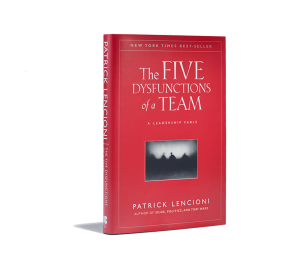
Patrick’s book is written as a novel with Kathryn as newly appointed CEO of DecisionTech, a promising start-up just outside Silicon Valley. She has an executive team of bright, competitive and high performing individuals. Kathryn is brought in because the company is not living up to the owners expectations and they are behind their competitors. It does not take long before she realise how crippled her executive team is. The book is the story of how she is coaching these executives from individuals to a team.
At the end of the book, Patrick has included a summary of the theories that has been presented through Kathryn’s leadership. This is a great resource to come back to whenever your want to refresh your memory of his model. But they are also spelled out through the story telling style that is used throughout the majority of the book. It is on the off-site workshop that these theories are presented to the executive team in this fictive but realistic story.
- Absence of Trust
It all starts with trust. There is a plethora written on the subject but Patrick boils it down to this: We have to trust that everyone have pure intentions. How this plays in the context of well functional teams is that we do not need to be protective or careful around the group. As a leaders we shall foster a secure environment where people can be vulnerable with each other.
- Fear of Conflict
Conflicts are good and an essential part of any well functional team. This is a scary thought to some people. Not all of us a comfortable with conflicts and avoid it to the longest. But Patrick is arguing that conflicts are what makes meeting interesting and the only real way to work through an issue. And this is key: we have conflicts about issues, not people. It is the ideological conflicts that we shall encourage and the destructive fighting and interpersonal politics shall be nipped in its bud.
- Lack of Commitment
I think Patrick is putting it so well when he is saying, “In the context of a team, commitment is a function of two things: clarity and buy-in.” We can see that the five dysfunctions are building on each other. We can only have clarity if we are listening to all opinions and dissecting the problem through the eyes of all the members. Patrick is also making it clear that commitment does not necessarily come through consensus. But we are normally willing to commit if we have been listened to and if our opinions have been weighted in the decision.
- Avoidance of Accountability
Accountability is about calling out behaviours that will hurt the team. The challenge for the leader is to create a culture where each member is willing to hold each other accountable. It is not just the leader that holds the others accountable, it is the team that holds each other accountable for success.
- Inattention to Results
Patrick is referring to the last dysfunction as the ultimate dysfunction. It is when the results of the group are not the most important thing for the group. It does not matter if one member of the group is successful if the team is failing. There are of course many things that could distract us from the group’s results but as leaders we can not let that happen. We need to publicly declare what results we are expecting, have some process to see if we are successful and reward great results.
Finally, I would like to say that although it is possible to summarise Patrick’s five dysfunction in a few hundred words, it is not an excuse for leaving this book in the bookshelf. Patrick has put all of these dysfunctions into context and addresses many of the pitfalls that are so common. He has also included several practical exercises that will help groups to move past these dysfunctions. It is a highly recommended book to read. If you do not already have it, you can buy your copy here.